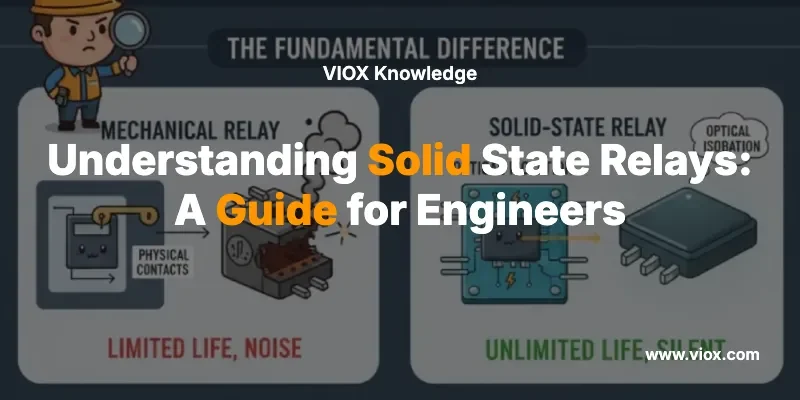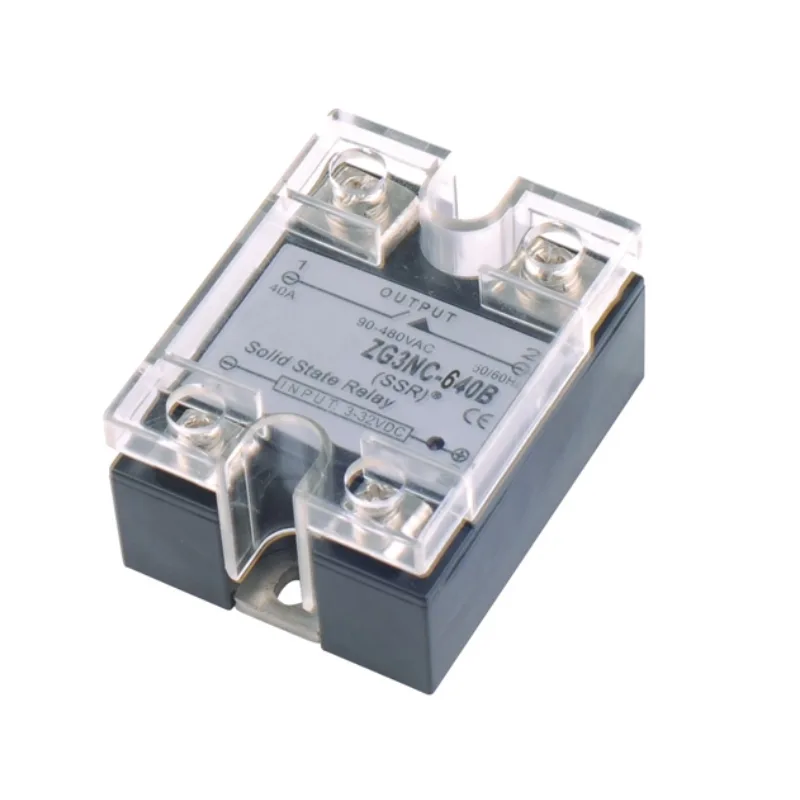You’re Speccing a Control System—But Which Relay Technology?
You’re designing a control panel that needs to switch heaters, motors, or solenoids hundreds of times per day. Your boss wants minimal maintenance. The production manager wants zero downtime. The procurement team wants cost-effective components.
You open the catalog and see two options: traditional electromagnetic relays and solid-state relays (SSRs). The SSR costs three times more, but the datasheet promises “unlimited mechanical life” and “no contact wear.”
So what exactly is a solid-state relay, how does it actually work, and when does the premium price make engineering sense?
The Fundamental Difference: Mechanical Motion vs. Electronic Switching
Here’s the core distinction that every engineer must understand:
Mechanical Relays use electromagnetic force to physically move contacts that open and close circuits. Current flows through a coil → creates magnetic field → moves an armature → switches metal contacts.
Solid-State Relays have no moving parts whatsoever. Instead, they use semiconductor switching elements (thyristors, triacs, or transistors) to control current flow electronically, with optical isolation between input and output.
Svarbiausia išvada: The SSR transfers signals through electronic circuits using light (via photocouplers), while mechanical relays transfer signals through physical motion. This fundamental architectural difference drives everything else—the advantages, limitations, and proper applications.
Inside the SSR: How Electronic Switching Actually Works
Let’s demystify the internal structure. An SSR consists of four essential components:
1. Input Circuit (Control Side)
- Contains a resistor and LED
- When you apply input voltage (e.g., 3-32 VDC), current flows through the LED, causing it to emit light
- The LED is your signal source
2. Electrical Isolation (The Critical Safety Element)
- A photocoupler or phototriac coupler sits between input and output
- The LED’s light crosses an air gap to trigger a photosensitive element
- This provides complete electrical isolation between control circuits and load circuits—crucial for safety and noise immunity
3. Drive/Trigger Circuit (The Intelligence)
- Receives the optical signal from the photocoupler
- Contains zero-cross circuits (for AC loads) that time the switching to reduce electrical noise
- Generates the proper gate signal for the output element
4. Output Circuit (The Power Switch)
- For AC loads: Triac or thyristor module
- For DC loads: Power transistor or power MOS FET
- Also includes protection elements: snubber circuits (resistor-capacitor networks) and varistors to handle voltage surges
Pro-Tip: The photocoupler isolation is why SSRs excel in noisy industrial environments. Electrical noise on the load side cannot cross the optical barrier to affect your control circuits—unlike mechanical relays where both sides are electrically connected through the coil and contacts.
The Three-Step Operating Sequence
Here’s what happens when you energize an SSR (using an AC load SSR as example):
Step 1 – Input Activation: Apply voltage to the input terminals → current flows through the input circuit → LED lights up
Step 2 – Signal Transfer: LED light crosses the optical barrier → photocoupler receives the light signal → generates electrical signal in the isolated output circuit → trigger circuit processes the signal
Step 3 – Output Switching: Trigger circuit sends gate signal to the triac/thyristor → switching element conducts → load current flows → your load (heater, motor, valve) turns ON
With zero-cross function: The trigger circuit waits until the AC voltage is near 0V before switching ON, dramatically reducing electromagnetic interference (EMI) and extending load life.
When you remove input voltage, the LED turns OFF → photocoupler stops conducting → trigger circuit removes gate signal → switching element stops conducting at the next zero-crossing → load turns OFF.
SSRs vs. Mechanical Relays: The Engineering Trade-offs
Let me give you the straight technical comparison that matters for design decisions:
Where SSRs Win Decisively:
1. Switching Life:
- Mechanical relay: Limited by contact erosion (typically 100,000 to 1,000,000 operations depending on load)
- SSR: Unlimited switching operations—semiconductors don’t wear out from switching
Pro-Tip: For applications requiring frequent ON/OFF cycles (>10 switches per minute, or >100,000 total cycles), SSRs eliminate the maintenance schedule entirely.
2. Switching Speed:
- Mechanical relay: 5-15ms operate time (limited by armature movement)
- SSR: 0.5-1ms operate time for semiconductor switching
- Critical for: High-speed counting, rapid pulse control, high-frequency PWM applications
3. Noise & Vibration Immunity:
- Mechanical relay: Moving armature can bounce in high-vibration environments; generates audible click and EMI from arcing contacts
- SSR: No moving parts = immune to shock/vibration; zero-cross function eliminates switching noise
4. Operating Environment:
- Mechanical relay: Contacts can be affected by dust, corrosive gases, humidity causing oxidation
- SSR: Sealed semiconductor elements are unaffected by airborne contaminants
Where Mechanical Relays Win:
1. Physical Size for High Current:
- Mechanical relay: Compact even at 30-40A (single relay footprint)
- SSR: Requires large heat sink at >10A, often exceeding mechanical relay size
- The reason: SSRs generate significant heat due to voltage drop across semiconductors (typically 1.5V), while mechanical relays have near-zero voltage drop across closed contacts
2. Multi-Pole Switching:
- Mechanical relay: Easy to implement 2, 3, or 4 poles in compact package
- SSR: Each pole requires separate semiconductor module—cost and size multiply
3. Initial Cost:
- Mechanical relay: $5-50 depending on ratings
- SSR: $30-200 for equivalent ratings
- However: Calculate total cost of ownership including maintenance labor and downtime
4. Output Voltage Drop:
- Mechanical relay: ~0.1V across closed contacts
- SSR: 1.0-2.0V across conducting semiconductor
- Poveikis: Power loss in SSR = 1.6V × 10A = 16W of heat to dissipate
Svarbiausia išvada: SSRs trade higher initial cost and heat generation for unlimited mechanical life and superior performance in high-frequency, high-vibration, or contaminated environments.
The Four Main Types of SSRs (Know Which You Need)
Understanding SSR classification is critical for proper selection:
Type 1: SSRs Integrated with Heat Sinks
- Load current: Up to 150A
- Taikymas: Mainly installed in control panels
- Examples: OMRON G3PJ, G3PA, G3PE, G3PH series
- Privalumas: Ready to install—heat sink is pre-sized and integrated
Type 2: SSRs with Separate Heat Sinks
- Load current: Up to 90A
- Taikymas: Built into equipment where you select heat sink to match housing
- Examples: OMRON G3NA, G3NE series
- Privalumas: Flexibility in thermal management design
Type 3: Plug-In Style (Same Shape as Mechanical Relays)
- Load current: 5-10A
- Taikymas: Drop-in replacement for mechanical relays, PLC I/O applications
- Examples: OMRON G3F, G3H, G3R-I/O, G3RZ series
- Privalumas: Can use same sockets as mechanical relays for easy retrofits
Type 4: PCB-Mounted SSRs
- Load current: Up to 5A
- Taikymas: Signal switching, board-level control, includes MOS FET relays
- Examples: OMRON G3MC, G3M, G3S, G3DZ series
- Privalumas: Compact footprint for direct PCB integration
Pro-Tip: For loads above 5A, you’ll almost always need to consider heat sinking. Below 5A, PCB-mounted SSRs work well without additional thermal management.
AC vs. DC SSRs: Critical Selection Criteria
This is where many engineers make specification errors. SSRs are load-specific:
AC Output SSRs (Most Common)
- Output element: Triac or thyristor module
- Load types: Heaters, AC motors, transformers, solenoids, lamps
- Zero-cross function: Available—turns ON near 0V to minimize EMI
- Voltage ratings: 24-480 VAC
Important limitation: Cannot be used for DC loads. The triac/thyristor requires the AC waveform to cross zero voltage to turn OFF. With DC, it stays latched ON.
DC Output SSRs
- Output element: Power transistor or MOS FET
- Load types: DC motors, DC solenoids, DC valves, LED arrays
- Voltage ratings: 5-200 VDC
- Privalumas: Fast switching (microseconds), no zero-cross delay
AC/DC Universal SSRs (MOS FET Relays)
- Output element: Two MOS FETs in series (allows bidirectional current)
- Load types: Either AC or DC—handles both
- Key feature: Ultra-low leakage current (10μA vs. 1-5mA for standard SSRs)
- Taikymas: Alarm outputs where load type is unknown, or where bleeder resistors can’t be used
Svarbiausia išvada: You must match SSR output type to your load. Using an AC SSR on DC loads will cause the SSR to latch ON permanently—it cannot turn OFF without the zero-crossing that only AC provides.
The Zero-Cross Function: Why It Matters
This is one of the most important SSR features, yet often misunderstood:
Without zero-cross function: When the SSR turns ON at a random point in the AC waveform (say, at peak voltage of 311V for 220VAC), the instantaneous current jump creates:
- Radiated electromagnetic noise
- Conducted noise on power lines
- Voltage transients from sudden di/dt (rate of current change)
- Increased stress on the load
With zero-cross function: The SSR waits to turn ON until AC voltage is within ±10V of zero-crossing. This means:
- Current rises gradually from zero
- Minimal EMI generation
- Reduced electrical stress on switching elements and load
- Extended life for resistive heating elements and incandescent lamps
When NOT to use zero-cross:
- Phase control applications (requires random turn-on capability)
- Fast response requirements where 10ms delay is unacceptable
- Testing/measurement applications requiring precise timing control
Pro-Tip: For 90% of industrial heating, motor control, and solenoid valve applications, zero-cross function is beneficial. The small turn-on delay (max 10ms at 50Hz) is negligible compared to mechanical relay operate time (5-15ms).
Heat Dissipation: The Non-Negotiable Requirement
This is the single most important concept for SSR reliability:
Every SSR generates heat according to: Heat (W) = Voltage Drop (V) × Current (A)
For example, a typical SSR carrying 15A with 1.5V drop generates: 1.5V × 15A = 22.5 watts of continuous heat.
This heat must be removed or the semiconductor junction temperature will exceed its rating (~125°C for most devices), causing:
- Thermal runaway and destruction
- Accelerated aging
- Short-circuit failure mode
The three heat management essentials:
- Select proper heat sink based on thermal resistance (°C/W rating)
- Apply thermal grease between SSR and heat sink (never skip this)
- Ensure adequate airflow in the control panel
For loads above 10A, heat sinking is mandatory. For loads above 30A, you’ll need large aluminum heat sinks plus forced air cooling.
The Bottom Line: When SSRs Make Engineering Sense
After understanding what solid-state relays actually are, here’s your decision framework:
Choose SSRs when you need:
- High-frequency switching (>100k total operations over product life)
- Noise-free operation in sensitive electronic environments
- Long maintenance-free operation in remote or difficult-to-access locations
- High-speed response (<5ms)
- Immunity to shock, vibration, and harsh atmospheres
- No audible click or mechanical wear
Choose mechanical relays when:
- You need multi-pole switching in compact space
- High current switching (>30A) with minimal heat generation
- Initial cost is the primary driver
- Voltage drop across the switch must be minimal (<0.2V)
- Low-frequency switching makes contact life acceptable
The hybrid approach: Many systems use mechanical contactors for main power switching and SSRs for high-frequency control signals—combining the strengths of both technologies.
Understanding what a solid-state relay fundamentally is—a semiconductor-based switch with optical isolation and no moving parts—gives you the foundation to make informed design decisions. The premium cost is justified when switching frequency, maintenance requirements, or environmental conditions make mechanical relay life unacceptable.
The key is matching the technology to your application requirements, not defaulting to what you’ve always used before.







